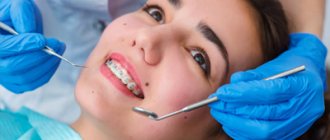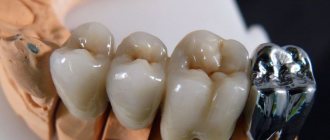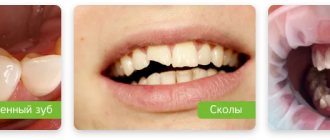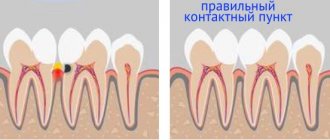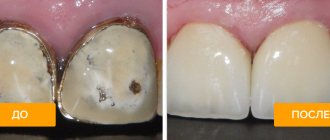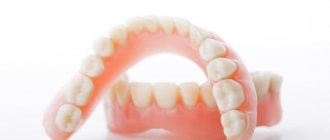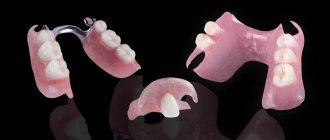With age, people's dentition becomes incomplete; various reasons are to blame: dental diseases, injuries, heredity. Over time, everyone faces the problem of choosing technology and ways to restore it so as not to suffer from imperfections in the functions of chewing, speaking and smiling. Patients often contact Amazing Price Dentistry asking for advice on the specifics of materials for modern prosthetics and choosing the best option for specific clinical conditions. Let's consider the question of which dentures are better to install - plastic or ceramic.
What are dental crowns
This is an artificial denture that is installed on a pre-treated natural crown. The purpose of prosthetics is to restore the anatomical shape, aesthetic appearance, and chewing function. Crowns can also be part of some other orthopedic structure: support for a partial removable or fixed denture, splinting for loosening of the dentition, etc.
Crowns on teeth
The design must meet certain requirements:
- restore the anatomical shape of the tooth, its aesthetics and color;
- support chewing and speech function;
- fit well to the neck of the destroyed tooth, make correct contact with neighboring units, as well as with teeth on the opposite side, without creating an obstacle to the closure of the dentition;
- do not interfere with the motor activity of the lower jaw;
- do not cause allergic reactions or tissue irritation.
All designs of this type have their pros and cons.
pros
Of all types of dentures, this one has a number of positive qualities, in some cases giving advantages over other types of prosthetics:
- rapid restoration of appearance and chewing function;
- large selection of materials for prosthetics;
- correct distribution of the load, eliminating the risks of abrasion of adjacent teeth and malocclusion;
- prevention of destruction of periodontal tissues and atrophy of jaw bone tissue;
- the ability to install several prostheses at once;
- if the root is partially destroyed, it is possible to install the prosthesis on a pin; if there is a complete absence of a root, it can be installed on an implant (titanium root).
Minuses
Negative qualities:
- the need to grind a tooth, sometimes a healthy one, if it performs a supporting function;
- a short period of discomfort after installation of the prosthesis; with the correct selection of material and compliance with installation technologies - very short;
- allergic reactions to certain dental materials;
- possible complications are reduced to a minimum with proper prosthetics;
- high cost of high-quality materials and insufficiently good appearance of cheap ones.
Preparation for prosthetics and its stages
Whether it is metal-ceramics or metal-plastic, the general technology of prosthetics with these materials is practically the same.
Preparatory activities include
professional visual examination and control x-ray to ensure there are no foci of inflammation. If there are any, they must be eliminated therapeutically;- if there are previously sealed canals, monitor their condition; if necessary, damaged seals are removed and new ones are installed;
- tooth depulpation procedure - nerves are removed followed by canal filling. When installing a prosthesis on a front tooth, this is mandatory; in the case of a multi-rooted tooth, the decision is made by the dentist based on the individual characteristics of the patient and the condition of the tooth. This need is caused by the high probability of pulp destruction with accompanying unpleasant symptoms, which will entail removal of the prosthesis and additional treatment. Therefore, this moment is extremely important;
- in case of carious tooth damage, therapeutic treatment is carried out until the process is completely eliminated;
- if the tooth is destroyed by less than 50%, then a pin is installed in the root canal. Next, the tooth crown is restored using filling materials;
- complete or critical destruction of the coronal part of the tooth requires the installation of a stump inlay.
Stages of prosthetics
- circular grinding of the tooth to the thickness of the walls of the crown, thus forming a stump;
- the color of the future prosthesis is selected using a special scale;
- a measuring impression is taken, on the basis of which the dental technician creates a metal-ceramic or metal-plastic prosthesis;
- the patient is temporarily (7-10 days) fitted with a special plastic crown. This is done to protect the ground tooth and eliminate the patient’s psychological discomfort, because a ground tooth looks unaesthetic;
- direct installation of the finished prosthesis, including fitting and, if necessary, adjustment.
Indications for installation of dental crowns
Dental crowns are installed for the following diseases and conditions:
- injuries and pathological processes of hard dental tissues, accompanied by the destruction of crowns by more than half and the impossibility of restoration with fillings - deep caries, increased abrasion, fractures and dislocations, wedge-shaped defects;
- congenital and acquired defects in the shape, height and position of teeth; congenital underdevelopment of crowns (hypoplasia);
- changes in tooth color - fluorosis, darkening after treatment;
- for support with partially removable and fixed dentures;
- as part of another orthopedic design, for example, splinting loose teeth due to periodontal diseases (periodontitis or periodontal disease).
By mounting method
In modern dentistry, various means of fixation are used. The comfort and duration of getting used to the structure will depend on the chosen method and quality of fastening. The orthopedic surgeon selects specific methods of fixation taking into account the individual clinical situation and the chosen method of prosthetics.
Creams and powders are considered one of the more reliable means of fixing removable dentures. A special product is applied to the denture, which is then pressed tightly to the oral cavity. Creams are recommended for patients with increased salivation, and powders are used for low salivation. If the structure of the jaw is abnormal, orthopedic doctors recommend using fixing strips.
Clasp-type dentures are secured using attachments or clasps. Alveolar processes are also used, which provide additional fixation. When putting on a removable denture, reliable fastening provides a suction effect.
Contraindications for installation
To place a crown on a tooth, you need to take into account not only the indications, but also the contraindications. Absolute contraindications include:
- healthy (intact) teeth; the exception is the situation when they are used as a support for other orthopedic prostheses;
- high pathological tooth mobility;
- chronic foci of infection of dental tissues that cannot be treated.
Relative:
- insufficient oral hygiene, caries - prosthetics are carried out after complete sanitation of the oral cavity;
- destruction of the crown by more than half - if the root is preserved, prosthetics are carried out after the pin is installed;
- destruction of the tooth root with its subsequent removal - prosthetics after implantation of a titanium root;
- chronic periodontitis (inflammation of the ligament that holds the tooth in the cell) - prosthetics after complete elimination of the causes of the disease - cysts, fistulas, etc.;
- not fully formed dental roots;
- severe general diseases - high blood pressure, stroke, myocardial infarction - prosthetics are possible after stabilization of the patient’s general condition.
Services of our clinic
Our dental center employs true professionals in their field. They know exactly how to choose the right crown, how to make it, and will do everything possible to make their patients happy.
Making crowns is a rather lengthy process. Various materials are used as the basis, such as titanium, platinum or gold. Next, porcelain is applied to the base. The result is an implant identical in color and shape to a natural tooth. It is worth noting that such crowns really are practically no different in appearance from real teeth. In addition, they are resistant to abrasion, aggressive dyes and various microorganisms.
In our clinic, dental prosthetics are performed at the highest level and in accordance with all standards. Our dentists will be able to not only make your smile beautiful and charming, but also restore all the functions of the lost tooth.
Types of crowns for teeth
Since dental crowns are designed for different purposes, they can be made from different materials. The orthopedist decides which crowns are best to put on the teeth in a particular case. Based on the material of manufacture, the following types of dental crowns are distinguished: metal, plastic, ceramic, metal-ceramics, glass-ceramics, zirconium dioxide, metal-plastic.
Plastic crowns for teeth
Temporary plastic crowns
Plastic (mostly acrylic) is a short-lived material, so currently a plastic crown on a tooth is mainly a temporary structure. These types of dental crowns have the following advantages:
- temporarily restore appearance, support chewing and speech functions;
- protect prepared (processed for prosthesis) teeth from pain when exposed to mechanical, chemical and temperature stimuli;
- prevent displacement and loosening of prepared teeth in the absence of their support by neighboring units;
- prevent the development of pulpitis and periodontitis with preserved dental pulp.
Minuses:
- possible burn of the pulp during installation, as well as allergic reactions to acrylic and inflammatory processes of periodontal tissues;
- fragility and breakage (but repair is possible using special glue);
- color change due to food coloring;
- limited validity period (2 years) - this is enough for temporary dentures, but not for permanent ones.
Metal crowns for teeth
Metal alloy crowns
These are the very first materials used to make dentures. Metal crowns on teeth are still in demand today, provided they are used correctly. They are made from alloys of precious and base metals with the addition of nickel, chromium, cobalt and other metals. Models made of gold are also alloys, since gold is a very soft and short-lived material, and the alloy will last for decades, having a beneficial effect on all tissues of the oral cavity. Models made of steel with gold plating are no different in appearance and wearability from gold ones, but do not have a positive effect on the periodontal tissues. If the question arises, which crown is better for a chewing tooth, dentists often recommend metal. Pros of a metal dental crown:
- validity period of at least 10 years; with proper care – decades; rarely break;
- biocompatibility with tissues;
- absence of corrosion in the alloys used;
- tolerate chewing load well;
- reasonable prices.
Minuses:
- not very attractive in appearance, since they differ as much as possible from natural units; therefore, they try to place a crown on a metal tooth on the lateral (chewing) units;
- sometimes they cause allergies and galvanic (electrochemical) reactions (if there is already a tooth made of another alloy in the mouth).
Ceramic crowns for teeth
Ceramic crowns
Ceramic tooth crowns are made from the most fragile material – pressed porcelain without any additions. They have their pros and cons. Pros of a ceramic dental crown:
- very beautiful – the appearance completely corresponds to natural teeth;
- strength;
- validity period - with proper care 10 years or more;
- completely biocompatible with tissues, do not cause allergies or gum irritation;
- do not change color when using food dyes;
- require minor grinding of hard dental tissues.
Minuses:
- fragile, breakages in the form of chips are more common than other materials;
- cannot withstand high chewing loads, so these crowns are placed on the front teeth;
- high price.
Zirconium dioxide dental crowns
Zirconium crowns
Zirconium crowns are made from the mineral zircon (silicon acid) through special processing using additives. The result is a very hard, durable material that also has the necessary plastic properties so that it can be used to make a denture. Zirconium crowns are made either from zirconium alone or by covering it with ceramics. The latter look more beautiful, so they cost more. Pros of a zirconium dental crown:
- the most durable material, service life - 15 years or more;
- zirconium crowns are beautiful - metal-free ceramics based on zirconium dioxide give a good aesthetic effect, but pure zirconium prostheses also look good;
- the possibility of manufacturing a structure for both anterior and lateral (chewing) units;
- completely biocompatible with human tissues, do not cause allergies or irritation.
Minuses:
- increased wear of teeth on the opposite side is possible;
- the top layer of ceramics may chip;
- high price.
Metal-ceramic crowns on teeth
Metal-ceramic tooth crowns have a metal alloy frame, which ensures the strength of the prosthesis, and a ceramic coating, which creates an aesthetic appearance. Advantages of a metal-ceramic dental crown:
- quite durable - service life is about 8 - 10 years;
- aesthetic appearance;
- cheaper than metal-free ceramics;
- if the frame is made of gold or platinum, then the prosthesis does not cause tissue irritation or allergies.
Minuses:
- metal-ceramic tooth crowns are not as beautiful as those made from porcelain or zirconium;
- chips of ceramics may appear;
- sometimes they darken, acquiring a grayish tint;
- frames made of base metals sometimes cause tissue irritation and allergies.
Glass-ceramic dental crowns
Glass-ceramic crowns
One of the most modern dental materials, combining high aesthetic qualities and sufficient strength. This type of dental crown is made on the basis of glass and ceramics using lithium disilicate (Empress Esthetic), lithium disilicate (E-max), zirconium silicate (Ceramage), etc. Advantages of a glass-ceramic dental crown:
- thin, therefore allowing for minimal tooth treatment;
- smooth surface and good adhesion to natural hard dental tissues - reduces the risk of developing caries;
- transparency and aesthetics - outwardly no different from the enamel of natural teeth;
- Lightweight design increases wearing comfort;
- do not change their color throughout use;
- validity period – more than 10 years;
- biocompatibility due to the absence of metal in the frame - does not cause gum irritation or allergic reactions.
Minuses:
- high price;
- hardness – can cause increased wear of teeth located opposite;
- fragility - can crack, repairing it is problematic.
Metal-plastic dental crowns
Metal-plastic crowns
A metal-plastic dental crown has a metal (usually base metal alloy) frame and a plastic covering. Temporary structures are most often made from this dental material, as it is not durable. A metal-plastic dental crown has the following advantages:
- ease of installation and repair of the structure;
- low cost.
Minuses:
- short validity period - about 2 - 3 years;
- allergies and tissue irritation may occur;
- loose fit to natural hard tissues – risk of caries and inflammatory diseases;
- color change due to the use of food coloring.
From the table you can find out which dental crowns are best suited for you:
| View | Aesthetic indicators | Period operation | Compatibility with the body | Allergy |
| Plastic | low | 2 years | not always | often |
| Metal | low | 10 or more years | not always | often |
| Ceramics | high | 10 years | high | No |
| Zirconium dioxide | high when combined with ceramics | 15 or more years | high | No |
| Metal ceramics | average | 10 years | not always | It happens |
| Glass ceramics | high | 10 or more years | high | No |
| Metal-plastic | average | 2 – 3 years | not always | It happens |
Pros and cons of metal ceramics
Advantages:
- They are visually pleasing, can be matched to the color of your teeth, and have the same visual properties as natural teeth.
- Durability. They are extremely durable dental materials that easily withstand the stress of chewing and years of wear and tear. Thus, they can last for several years.
- Minimal grinding.
Flaws:
- Some patients have individual intolerance to metals.
- The ceramic part sometimes peels off from the metal structure.
Are you interested in a metal-ceramic crown? The price is clarified in the corresponding section of our website, by phone or directly at the dentist’s appointment.
Which crowns are best for teeth?
All types of dental crowns have their own indications and contraindications. Certain types are used on different teeth. Recommendations about which crown is better for the chewing tooth and which for the front tooth are given to the patient by the orthopedist. But, for example, a metal-ceramic crown can be installed on any tooth.
Crowns for front teeth
Incisors and canines are always visible when talking and smiling. In total, each jaw has 4 incisors (2 central and 2 lateral) and 2 canines. Their main function is to bite food, create an aesthetic appearance and maintain correct diction. What crowns are best for such teeth? Most often, ceramics and glass-ceramics are used for crowns on the front teeth. These dental materials allow you to create the maximum aesthetic effect, as well as maintain chewing and speech function.
Crowns for lateral (chewing) teeth
These types include premolars and molars. When smiling, they are not always visible (sometimes 1 premolar is visible) and perform a chewing function. Crowns on chewing teeth are most often installed metal or zirconium. At the patient's request, glass ceramics can also be used. If the first premolars are visible when smiling, ceramics, glass ceramics or zirconium crowns are installed on them.
The final decision on which crown is best suited for a chewing tooth is made by the doctor together with the patient. Plastic or metal-plastic is most often used as a temporary structure.
Let's compare the disadvantages
The materials discussed in the article have not only advantages, but also disadvantages.
Disadvantages of metal-ceramic crowns
- It is necessary to grind down more of your own tooth tissue due to the large thickness of the walls of the prosthesis.
- Almost always, tooth depulpation is required.
- An allergy to metal (except precious metals) may develop.
- If manufacturing technology is violated, artificial teeth may have a darker color.
Disadvantages of metal-free crowns
- High price.
- Complex manufacturing process.
- Slightly inferior in strength to metal.
Based on the totality of these characteristics, it can be noted that zirconium or metal-free crowns are better than metal-ceramics and can be recommended to those patients who want to get the most beautiful smile.
Installing a crown on a tooth
The process of installing a crown on a tooth is strictly regulated. It is carried out in stages. The appearance, functionality and lifespan of the prosthesis depend on how the crown is placed on the tooth and how carefully the work is done.
Inspection
Installing a crown on a tooth begins with an examination by an orthopedic dentist. He examines the oral cavity and, if necessary, prescribes x-rays. Based on the results of the inspection and examination, preparatory measures are carried out.
Treatment
A complete sanitation of the oral cavity is carried out. Treatment includes caries, gum and oral cavity diseases. In severely damaged units, the pulp is removed and the root canals are cleaned (depulpization). Professional dental cleaning is required. Only after the doctor is convinced of the complete absence of foci of infection can prosthetics be performed.
Turning
It is not easy to crown a tooth. To install a crown on a tooth, it needs to be ground - remove the surface layer of hard tissue with a thickness equal to the thickness of the future prosthesis. Structures can be made of different materials and have different thicknesses, so turning will also be carried out to different depths.
Grinding a pulpless tooth before installing a crown is painless. It is recommended to grind a living, non-pulpless tooth under local anesthesia.
Taking an impression and making a model
An impression or impression is taken from a unit that is fully prepared for prosthetics, reflecting the condition of the prosthetic part of the dentition. For this purpose, an elastic dental material is used that retains its shape for a long time (silicone mass, dental wax, plaster).
The oral cavity is dried, the material selected for making an impression is placed in a special mold (spoon), and it is applied to the place of prosthetics in the dentition. The patient can only clench his jaws and keep them clenched for several minutes until the impression hardens. The resulting impression is washed under running water, placed in a special solution and sent to a dental laboratory. Using the cast, a plaster model is first made, it is tried on, and then a prosthesis is made from the selected material.
Fixation of crowns
The installation of the crown ends with its strengthening - fixation. First, the crown is strengthened with a temporary compound. The patient wears the prosthesis, assessing the degree of comfort, for 2 to 4 weeks. If everything is normal, the temporary fixation is replaced with a permanent one, strengthening the prosthesis with cement. If the prosthetic unit has enough natural tissue, then the prosthesis is placed directly on the treated and filled tooth. If there is not enough tissue, the prosthesis can be fixed on an inlay, a pin or an implant (titanium root).
On the tab
Fixation of the crown on the core tab
This is the best option for prosthetics. The inlay is made in the laboratory from an impression and reliably covers the damaged tooth. Even if the crown is destroyed for some reason, the inlay will not be damaged and re-prosthetics can be carried out easily. A prosthesis on an inlay can last a very long time, from 7 to 10 years or more, depending on the material of manufacture.
On the pin
Crown on pin
The orthopedist decides which crown is best to install on the chewing tooth and how to strengthen it, but most experts believe that a supporting structure in the form of a pin is most suitable. The pin is inserted into the preserved tooth root when there is significant destruction (at least half) of the crown. Before this, treatment and removal of pulp from the root canals is carried out. Contraindications for the installation of a pin are any inflammatory processes, including pulpitis and periodontitis, split roots, narrow curved root canals.
Pins are placed mainly on the lateral (chewing) teeth, but sometimes on the front teeth. The price depends on the material of manufacture. Cheaper metal ones with threads (anchors) are placed mainly on chewing teeth. More modern fiberglass ones are transparent, without threads, installed on cement.
On an implant
Crown on an implant
An implant is a titanium root that is implanted into the jawbone. Installed when the root is destroyed, on which it is impossible to install a pin. Dental implantation can take place immediately after removal of the natural root (single-stage technology) or after some time (delayed).
An adapter (abutment) is installed on top of the titanium root, onto which the prosthesis is attached. The abutment can be metal and then it will be visible through transparent metal-free crowns. Zirconium abutments can be placed on any teeth, metal ones - mainly on the lateral ones. Usually, a temporary structure is first installed, and after the implant has healed, it is changed to a permanent one.
Main types of metal-free structures
Metal-free crowns do not have a metal frame and can be made from the following materials:
- Porcelain. Porcelain crowns are made by firing and subsequent glazing. This method allows you to obtain a fairly durable and at the same time aesthetic denture.
- Zirconium dioxide. The most popular material today. Like cermets, zirconia serves as a framework onto which the ceramics are applied. Only the latter material has a natural white color and does not change the shade of the artificial tooth, unlike dark metal.
It is worth noting that metal-free prostheses are manufactured using modern CAM/CAD technology. This technique is considered the most advanced today and allows you to achieve outstanding accuracy of the finished crown. After the doctor takes impressions of the jaws, they are transferred to a computer, which cuts out the frame from a zirconium dioxide blank with maximum precision. A crown made in this way does not require further adjustment and grinding after installation.
In general, metal-free crowns can be considered the most modern, aesthetic and expensive.
Possible complications
Depends on how the crown is placed on the tooth. If all indications and contraindications for prosthetics are observed, the correct choice of dental material, prosthetic technique, and high-quality performance of all work, complications, as a rule, do not occur or are reduced to a minimum. Sometimes the cause of complications is the individual characteristics of the patient’s body.
Pain under the crown
After treatment and prosthetics, moderate pain may persist for some time (1–5 days), decreasing in intensity. But if the tooth under the crown hurts, and the pain does not decrease, but increases, tissue swelling appears, pus is released from the gums or the temperature rises, you should immediately consult a doctor - this is a sign of an inflammatory process. The cause of inflammation may be incompletely cured caries or incompletely removed pulp from the root canals. Another reason is violations during the installation of the prosthesis, its loose fit to the remains of the natural crown and infection getting under it.
Pain under the prosthesis with irradiation into the jaw also occurs when the root canal is perforated with a pin or when a small part of the instrument used to clean the root canal is broken off. What to do: you should not try to treat a bad tooth on your own; this requires urgent help from a dentist. Usually the crown is removed, the pathological process is treated, and then the crown is reinstalled (new or old, if it is not destroyed). Sometimes pathology can be eliminated without removing the crown, simply by drilling a hole in it. The hole is then repaired using photo-curing filling materials.
If the toothache under the crown is very severe, before seeking medical help, you can take a painkiller: Paracetamol 500 mg tablet, Ketorol 10 mg or Naise 100 mg.
Unpleasant smell
Indicates the presence of an infection in the mouth. This may be a slow inflammatory process, or it may be an acute one, in which case the tooth also hurts. The cause of an unpleasant odor from a tooth under a crown can also be insufficient oral hygiene, smoking and eating a lot of sweets. What to do: consult a doctor; this symptom can only be eliminated in the dentist’s office.
Allergy
Allergic reactions are most often associated with the installation of crowns made of non-precious alloys of metal and plastic (acrylic). Redness and swelling of the gums and pain appear. The allergic process is dangerous because it can quickly spread to surrounding tissues. At the same time, the tissues of the larynx swell, breathing is impaired (Quincke's edema). What to do: contact your dentist immediately. Help consists of replacing the prosthesis that has caused an allergy to a structure made of a different material. At home, the patient can take a tablet of any antihistamine: Zodak, Claritin, Tavegil, etc.
Caries
The cause of the development of dental caries under the crown is most often incompletely cured primary caries. But sometimes, even after careful treatment, caries develops again (secondary caries). This happens especially often when the crown does not fit tightly (an infection gets under it), poor oral hygiene, or consumption of large amounts of easily digestible carbohydrates. What to do: Contact your dentist as soon as possible. The product is removed, caries is treated, and then the structure is reinstalled. If it is worn out, install a new one.
Prosthetic stomatitis
The appearance of painful ulcers on the gums in the area of prosthetics and their spread to the oral mucosa largely depends on how the crown is placed on the tooth. Prosthetic stomatitis is a consequence of improper design or installation of a crown, squeezing small blood vessels of the gums, leading to malnutrition and destruction of the mucous membrane. Sometimes the cause of stomatitis is the toxic effect of dental material (acrylic) on oral tissue. If an infection is added to the inflammation, stomatitis can be purulent. What to do: consult a dentist, find out and eliminate the cause of the complication.
Common questions from clients
why do the gums darken near the crown??
- Error when preparing a tooth for a crown.
- Error in the manufacture of the crown (non-certified metals or the frame overlaps the ceramics on the outer surface).
- Root caries (a carious process has occurred under the crown), that is, the seal of the crown is broken.
- In all cases, urgent replacement of the structure is required. Failure to follow the recommendation will result in tooth extraction.
why does the tooth under the crown turn black??
the tooth has turned black - this is a symptom of tooth tissue destruction and requires immediate treatment. The dentist will remove the crown and evaluate the condition of the tooth. If a small part of the tooth has darkened, you can fill the tooth and make a new crown.
Is it possible to redo zirconium crowns? ?
Can. For example, if the color of the crowns is radically different from their own. In this case, the crown is sawed and removed without damaging your tooth.
Most often, it is impossible to change the color of the crown without removing it. Unless we are talking about some completely insignificant defect, which can really be eliminated by slightly tinting the porcelain.
If the discrepancy is really serious and very noticeable, the crown will have to be removed and re-fired in a dental laboratory. This is undesirable as it may change the density of the porcelain. In addition, only a crown installed on temporary cement can be removed and put back - when removing a prosthesis installed on a permanent basis, it can become irreversibly deformed.
Is it possible to change the shape of a zirconium crown??
Some changes in shape can be made if the crown is installed with temporary cement.
The ceramic on the crown chipped, why?
- Bruxism (teeth grinding).
- Technical shortcomings in crown manufacturing.
- Incorrect determination of occlusion by the dentist.
- In all cases, urgent replacement of the structure is required. It is impossible to repair high-quality ceramic crowns; replacement is required.
The crown fell out, how did that happen?
- Consultation with a dentist is required.
- If the crown falls out before a year after manufacture, most likely an error was made during prosthetics (subject to fixation with permanent cement).
- If many years have passed, then there are too many options, this requires immediate intervention from a specialist.
Double crown or two separately – which is better?
It is better to make a connected common denture for two teeth.
Why does the tooth under the crown hurt?
- In almost all cases, it indicates problems in the supporting tooth. Immediate consultation with a specialist (orthopedic dentist, therapist and surgeon) is required.
Caring for dental crowns after prosthetics
How long the installed structure will last depends not only on the quality of dental services, but also on proper care. After installing a crown, it is important to follow these recommendations:
- You will be able to eat 2 hours after installation of the prosthesis, and drink immediately;
- For the first few days, it is better to chew solid food on the opposite side; over time, the load can be increased, but you should no longer chew nuts at all;
- after installing prostheses made of plastic or metal-ceramics, it is better to avoid taking coloring foods: coffee, beets, red wine, etc.;
- after each meal you need to rinse your mouth, using an irrigator to rinse the interdental spaces; It is better not to use dental floss, as they can damage the denture;
- brush your teeth twice a day with a soft toothbrush and toothpaste without abrasive particles; President pastes with an RDA abrasiveness rating of less than 50 units are suitable. (Preggy for pregnant and nursing mothers and Junior).
Crown care products
Structural materials in prosthetics
A modern dentist has a sufficient amount of materials for making dentures in his arsenal.
In modern prosthetics, materials such as: Plastic are used. Used for the manufacture of temporary crowns, and removable acrylic and nylon structures. Plastic products do not last long, so they will need to be replaced after a while.
Metal. Gold-containing and cobalt-chromium alloys are widely used. Metal crown frames and clasp dentures are very common.
Zirconium. Zirconium oxide and dioxide are ideal materials for restoring dentition in the chewing area. The ceramic coating of zirconium crowns gives the product a natural shine.
Ceramics. This material is valued for its properties that are as close as possible to natural tooth enamel. For ceramic products, you can easily choose the desired shade. The main disadvantage of ceramics was previously considered to be low strength, but with the beginning of the use of sodium disilicate in prosthetics, this parameter improved. A good example of the use of ceramics is E-Max crowns.
Which dental prosthetics is better and cheaper is a question that only his attending physician can answer for each patient. Much depends on the location of installation - anterior or chewing teeth, the level of qualifications of the specialist and the nuances of a specific clinical situation.
How much does a tooth crown cost?
To find out how much it will cost you to install a crown on a tooth, you will need to make an appointment with a prosthodontist. During your consultation, a specialist from the St. Petersburg clinic “Yulistom” will recommend the type of crown that is most suitable for you and will evaluate the amount of work involved in preparing and carrying out prosthetics. All this will add up to the total cost of installing the prosthesis. The cost also depends on the location of the clinic, its accreditation category and the qualifications of the specialist performing the work. Only a dentist can decide which crown is suitable for the chewing tooth and which for the front one so as to have a sufficiently high quality prosthesis at minimal cost.
The price range (cost of product + cost of work) can be significant:
- metal made of base alloys - from 3,000 to 16,000 rubles;
- metal ceramics - from 7,000 to 40,000 rubles;
- ceramic – from 20,000 rub. and more.
Zirconium - an alternative to metal ceramics?
Above we compared all the advantages, disadvantages and features of both materials. Based on the information presented, we can conclude that zirconium and metal-ceramic crowns are worthy options for prosthetics, but they are designed for different groups of patients. Metal-ceramics can be used for those patients who value reliability, reasonable cost and do not need ideal aesthetics. Zirconium crowns are chosen by those patients who are most concerned about the aesthetic issue and other characteristics are not so important.
